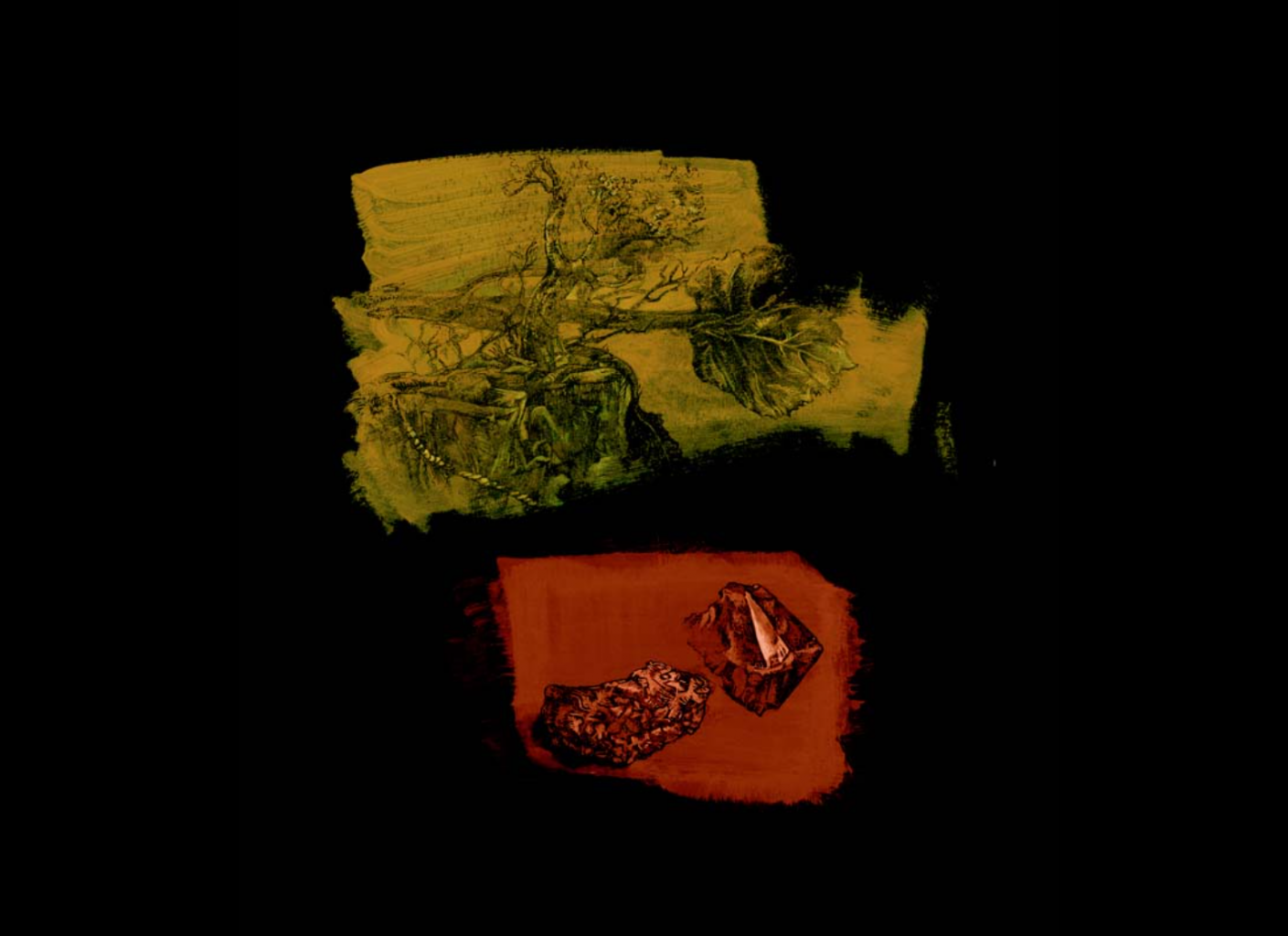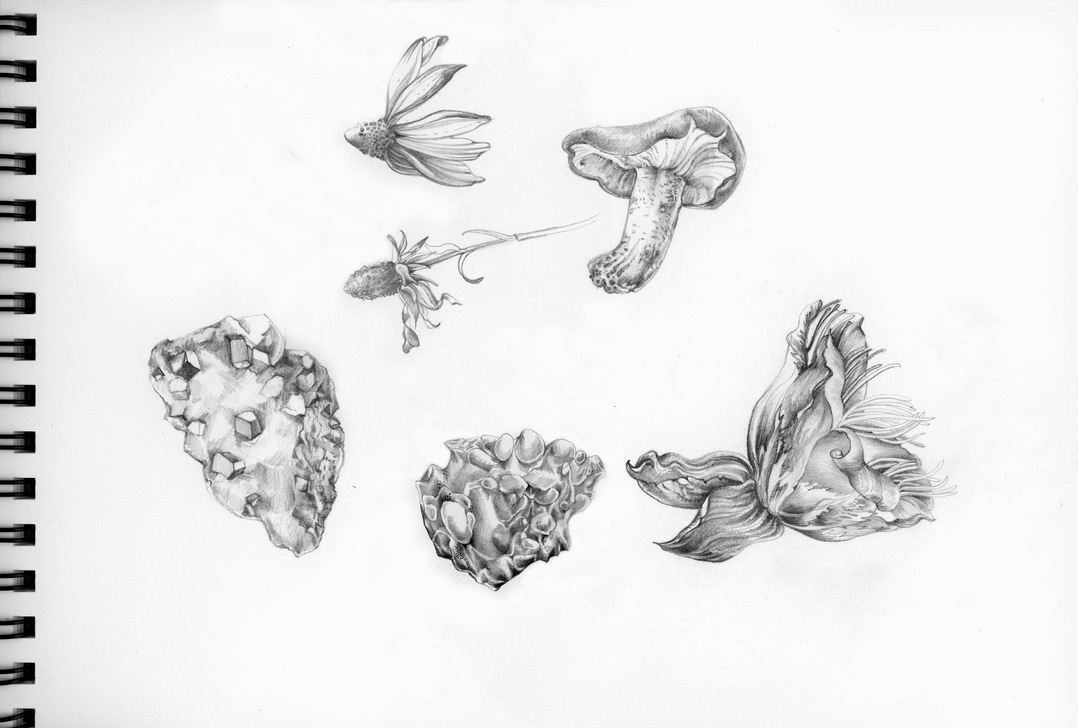Territory That I Know
The making of poetry, paintings, and Umwelt.

I received an email from my friend, the painter Ellen Wiener, in which
she mused upon the global reach of her grown children’s curiosity
compared to the more focused and, as she acknowledges, Eurocentric
purview of her own. “We are sliding,” she wrote, “and in most ways
rightly so, into a much more global awareness. My children want to visit
Mexico City, Japan, India . . . and my inspiring explorations are
apparently in some London of 1785.” With the kind of sympathetic magic
that has graced our correspondence for more than a quarter-century, her
message arrived as I was spending a concentrated block of time each
morning in something like the same historical neighborhood as she,
albeit a dozen years later and some 130 miles to the west. If she has
been figuratively cultivating botany at Kew and admiring the
recognitions constellated at the museum of Sir John Soane*, transforming
both into gem-like images that float in time and space with elemental
grace and uncanny gravity, I have been wandering the Quantock Hills with
two youthful poets and assorted companions in the pages of Adam
Nicolson’s The Making of Poetry: Coleridge, the Wordsworths and Their Year of Marvels.
The
year of Nicolson’s title, which straddles 1797 and 1798, saw, in the
author’s estimation, a transformation in the human imagination. The
vehicle for this revolution was a small volume entitled Lyrical Ballads, in
which the otherworldly (“The Rime of Ancient Mariner”) and the
conversational (“The Nightingale”) flowed from Coleridge’s quill and
Wordsworth brought his lofty brow to bear on humble characters and
naturalistic scenes, translating them into vernacular verse that gave
English literature a new vocabulary and syntax of seeing. “These
months,” writes Nicolson of the period his narrative ambles through with
knowing appreciation of its natural setting and creative climate,
are when Coleridge started to develop his theory of imaginative education, of a mind shaped by the image-filled worlds into which a child can disappear; and Wordsworth began to discover the opposite, of childhood as the realm not of creative freedom but of unadulterated experience, of moments and spots of time that burned themselves into a child’s being, so that memory became the sculptor of the person.
I
can’t easily dismiss the book’s claims for the poet’s reach, for it’s
those two orders of apprehension that, on reflection, have shaped my own
perception, if not understanding, of presence in the world, although I
never recognized it so clearly until Nicolson provided the lens to see
it. That the lens is that of poetry, and 200-year-old poetry at that,
only augments the worrisome sense of anachronism that has had me
wondering what exactly is the point of immersing myself, via Nicolson’s
literary labor, in the notebooks and discarded drafts of Coleridge and
Wordsworth as, day by day, in whatever direction one happens to look,
the country seems determined to go to hell in a handbasket. Not for
nothing did I copy out Ada Calhoun’s description, in her recent memoir, Also a Poet: Frank O’Hara, My Father, and Me, of
her exasperation as she listened to some of the decades-old interviews
her father had conducted with Frank O’Hara’s self-absorbed New York art
world contemporaries: “Why was I still listening to these people talk? I
needed to focus attention on the present, where my father might be
dying.” My father might be dying, too—is certainly dying,
sooner rather than later, but nonetheless resort to the Quantocks has
consoled me as I struggle with the paradoxical enervations, both patient
and urgent, of his care, ignoring the anarchies loosed on larger lives
as I tend one small, dear one.
“To them I may have owed another gift,” writes Wordsworth in the last poem in Lyrical Ballads,
Of aspect more sublime; that blessed mood,
In which the burthen of the mystery,
In which the heavy and the weary weight
Of all this unintelligible world,
Is lightened:—that serene and blessed mood,
In which the affections gently lead us on,—
Until, the breath of this corporeal frame
And even the motion of our human blood
Almost suspended, we are laid asleep
In body, and become a living soul:
While with an eye made quiet by the power
Of harmony, and the deep power of joy,
We see into the life of things.
If
I’m honest, the consolation I take from literary endeavors in the
present fraught moment is just a happy byproduct of what I’d be doing
anyway, because savoring the sentences of other writers, or turning my
own around, are what my mind and heart have become habituated to in the
course of nearly seven decades. Having learned to do both to at least a
private level of satisfaction, they form, after all this time, the
landscape I inhabit.
The epigraph to The Making of Poetry is a quotation from a radio interview with Seamus Heaney:
The making of verses, the making of works, occurs in the edges of your life, of your time, in your late nights or early mornings . . . And my words, the words for me, seem to have more nervous energy when they are touching territory that I know, that I live with . . .
All
our thought and feeling, whatever the venue we use to capture it, is
more vivid when it touches territory we know; most of us, in the age of
uprooted, portable relations in which we are both blessed and cursed to
abide, do not inherit that territory but have to construct it. As those
constructions age and weather, or are overtaken by the flotsam and
jetsam of the rising newsfeed tide, they seem less resilient, more
defensive, less ingenious and spontaneous than they once did. I feel
more and more provincial every day: what once seemed an admirably and
oddly eclectic set of interests—right now circling around the paintings
of Joan Mitchell, the letters of Sylvia Townsend Warner, the films of
Agnès Varda, obscure corners of the string quartet repertoire—seems
increasingly parochial, as if I’m the parson of some rural church
tending gravestones whose inscriptions grow fainter with each passing
week.
Ellen
and I are roughly the same age, so I suspect some of the vocational
fixity she ponders in herself as she admires her children’s wanderlust
is the result of the natural seasoning of impulse. But she is on the
track of something more profound: the way the traditions on which our
skills—more tellingly, our intuitions—have been nourished can begin to
feel antique; not just venerable, but brittle. With comic ruefulness,
she tells me how unused digital drawing instruments—gifts from her
son—scold her from a nearby shelf as she goes about her habitual
business: “I sharpen cylinders of graphite. Guilty.”
What she does with those cylinders of graphite, on the other hand, is filled with the innocence of inspiration, tempered by the long sentences the work itself hands down with its own inescapable judgement. First is the drawing, she tells me when I ask about how Leaf & Underlain, spied on Instagram (@ellenwienerart), is made:
Detailed pencil studies of rocks, plants and landscapes—as in

These are then transferred lithographically by hand or on the etching press (surely you don’t want the chemistry?) onto a colored ground and painted. Then scanned, resized, recolored & tweaked in photo shop. Then printed using Epson 900 inkjet. Then hand colored again with gouache, colored pencil, pastel and oil. All on paper.
Leaf & Underlain is one of a group of works Ellen calls “Bigeminals” (you can see them all at her website), because
it embeds the word GEM but also because there is a break, a stutter between the images—as each pair needs a heartbeat of blank before the looker can begin linking the fragments. Each “duet” can be seen as the landscape and what essential ingredients & elements lie underneath.
Floating
on their black ground, the Bigeminals strike me as minerals mined out
of thin air. They have the heft of rock and the ethereal beauty of
jewels you can see into, light leading you through long vistas of
formation with its frolicsome poise, time unleashing all its tenses in
the same moment of looking. They’re like specimens from the field
sketchbooks of Gabriel García Márquez, if he had only been a fossil
hunter (which, come to think of it, he was).
“I
guess what I’m trying to illustrate are miniature myths,” Ellen
explains to me, “. . . the mood is poignant though—as in looking at
souvenirs.” In this context, the word souvenir unfolds in time, unwinding its history from its current meaning of “memento” through its French forebear in the verb se souvenir—to keep the trace of someone, something in memory—and back to the Latin subvenire:
to come to help, come to mind. The nervous energy of which Seamus
Heaney speaks, that animates words into poetry, is found along the roots
of that etymology, in the coming to mind that comes before souvenirs
become commodities, when they move like creatures through the
imagination. There is a cryptography to consciousness: a thought
Coleridge, if not Wordsworth, would have loved to ponder.
I
discovered a word recently and, with the serendipity fresh knowledge
invites, now seem to be stumbling upon it everywhere. It was coined by
the zoologist Jakob von Uexkűll, who, in the years between the two world
wars of the twentieth century, “transformed the study of animal
consciousness,” as David Trotter recently wrote in the London Review of Books (in
a piece, believe it or not, on Sylvia Townsend Warner), “by
demonstrating that all organisms experience life in terms of a
species-specific, subjective, spatio-temporal frame of reference
uniquely adapted to the environments they inhabit. He called this frame
of reference an Umwelt, or immediately surrounding ‘world’.”
It’s no different for human beings, as far as I can see: our Umwelt is
the territory we know. There we wander, sometimes without leaving home,
among all the souvenirs that we’ve assembled, or are assembling us:
Ellen sharpening graphite cylinders while I deploy semicolons not so far
away, on the other side of Long Island Sound.
❖
*Note on Sir John Soane: At 13 Lincoln’s Inn Fields, facing the largest square in the city, an elegant small house conceals behind a modest façade the most remarkable and personal museum in London, perhaps in all the world. Its creator had an extraordinary career: beginning as a bricklayer’s boy, John Soane (1753-1837) became an eminent architect whose innovative elaborations of Greek and Roman motifs produced such influential buildings as the Bank of England and the Dulwich College Picture Gallery. Bequeathed to the nation by its owner upon his death, Sir John Soane’s Museum is crammed with sculptures, paintings, and curiosities that occupy every available inch of wall and floor space. The Picture Room, for instance, a chamber of modest dimensions, is designed with such ingenuity that it contains more than 100 works—including compositions by Canaletto, Piranesi, Hogarth, and Turner—arranged on walls that are hinged screens, each opening out to reveal new layers of paintings and drawings behind. All in all, the museum is a wonder-cabinet bursting with astonishing contents and cultural resonances, including more than 7,000 books, a seemingly endless supply of artifacts and antiquities, and such singular items as the sarcophagus of the Egyptian pharaoh Seti I.
